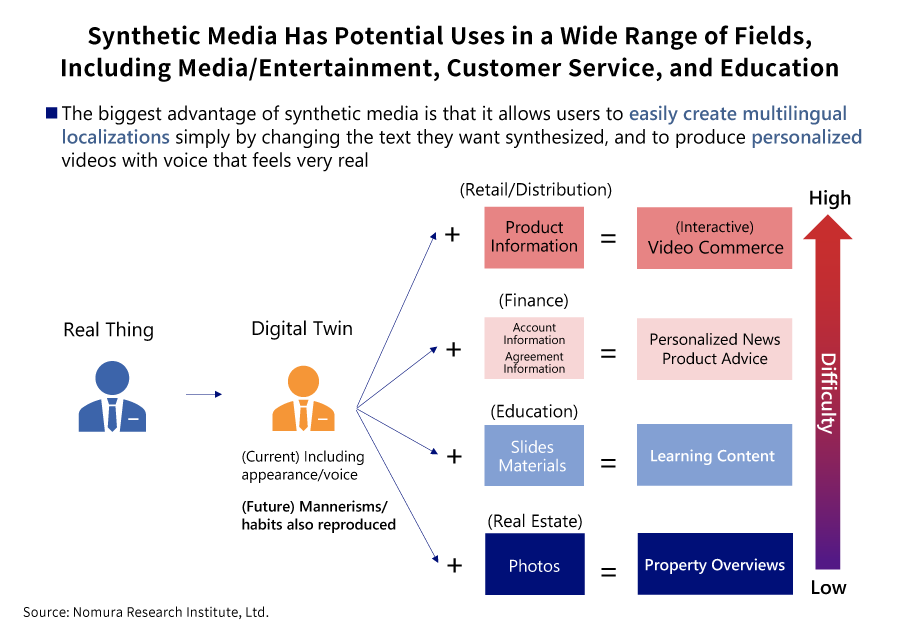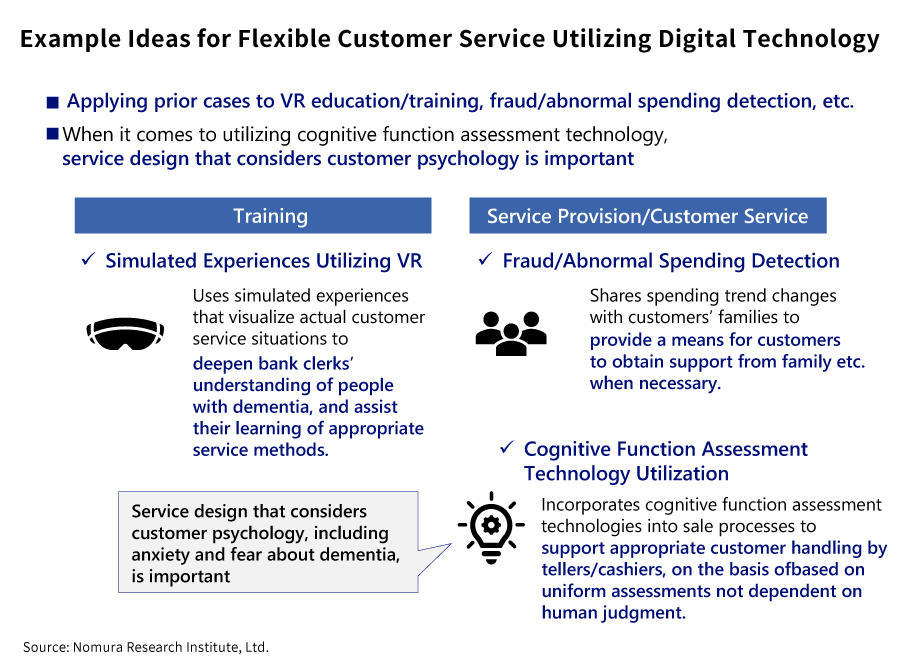
IT Roadmap 2021: Exciting Changes in Information Technology over the Next Five Years!
Every year, Nomura Research Institute (NRI) publishes “IT Roadmap” to analyze the latest trends in IT and to forecast trends for the next five years. The 2021 edition introduces the latest trends and the outlook going forward for “synthetic media” and “gerontech”.
Synthetic Media – Yoshiaki Nagaya, IT Platform Technology Strategy Department
Synthetic media makes it possible to produce real moving images with voice at low cost in a short time
Synthetic media is a moving image synthesis technology that uses AI to create real moving images with voice. From a pre-prepared text and video of a person, it is possible to generate moving images that give the impression that the person is actually speaking.
“Virtual Teresa Teng”, a full CG video created by U.S. company Digital Domain in 2013 to mark the 20th anniversary of the death of Taiwanese singer Teresa Teng, required contributions from many creators and was produced at a cost of roughly 1.6 billion yen over five months. In contrast, “Fake Zuckerberg”, which was created using synthetic media by the startup Canny in 2019, was produced by having AI learn publicly available data over a period of approximately 24 hours, and this process made it possible in an extremely short time to easily create a video that gave the impression of Mark Zuckerberg speaking.
Beginning last year, the video utilization needs in fields such as education and customer service expanded dramatically in response to the coronavirus pandemic. In addition, video customer service that utilizes digital signage rapidly became normalized. In the future, synthetic media has the potential to develop into a high-productivity video production technology that could replace conventional studio recording.
Synthetic media utilization expands in finance and real estate
Xinhua News Agency has been using “AI news anchors” created with synthetic media since 2018. AI news anchors are easy to localize in diverse languages and, considering their 24-hour responsiveness, are ideal for breaking news broadcasts.
Likewise, the U.K. media giant WPP has used synthetic media to create multilingual content for company training. The costs of a conventional production would have been 10,000 dollars per 20 languages, but synthetic media utilization cut those costs to 10,000 dollars for the entire project, and significantly reduced production time as well.
It appears likely that synthetic media will also be useful in the financial sector, for facilitating the efficient creation and provision of “news videos with voice” that can personalize very fresh information, and among insurance agents, for creating marketing support videos that provide understandable explanations of new product features in accordance with customer attributes.

Challenges and prospects for synthetic media
With current synthetic media, it is possible to use today’s AI technology to reproduce face and voice with almost no uncanny valley effect; however, for the technology to improve to cinema quality and faithfully reproduce facial shading and texture on a large screen, face data has to be acquired in large volumes using dedicated facilities.
At the same time, synthetic media carries the risk of abuse, and could lead to an increase in “deepfakes” (fake videos) masquerading as famous people. Because of this, the researchers and companies dealing with synthetic media have begun instituting ethics guidelines which stipulate, for example, that synthetic media will not be created without the express consent of the individual in question. In 2020, Facebook and other companies sponsored a contest that sought to use AI to expose deepfakes, but the best detection rate among competitors was only 65%. Going forward there will be a need for AI technologies that can expose deepfakes.
Gerontech – Akiko Gondo, IT Platform Technology Strategy Department
Gerontech supports the elderly and their caregivers
The term “gerontech” is a portmanteau of “gerontology” and “technology” and refers to technologies intended to solve the problems faced by the elderly. In recent years, the growing number of elderly people with diminished cognitive function has become widely known as a social problem. The Ministry of Health, Labour and Welfare estimates that by 2025, one in five elderly people will have dementia, suggesting that this social transformation will occur earlier in Japan than in other countries.
Technology utilization in financial gerontology
Financial gerontology is a field of research that applies knowledge from gerontology to financial problems such as individual portfolio selection and asset management.
A growing number of concerns are being raised in connection with declining cognitive function, with elderly clients and their families asking whether they (or their parents) will be okay if dementia renders them incapable of withdrawing money personally, while financial institutions wonder whether they should process transactions when the elderly come to the window accompanied by people claiming to be relatives. As a result of this rising awareness of societal problems and the progress of technology, initiatives for the advanced elderly are accelerating, including “support for expense payment processes”, “asset protection”, and “dementia insurance”. Trust banks have begun offering cash withdrawal support services for elderly people that can be carried out by agents, and insurance companies are moving forward with the implementation of services ancillary to dementia insurance, including the provision of cognitive function assessment tools.
Cognitive function assessment technology will be an area of interest going forward
Cognitive function assessment technologies that can perform measurements easily via tablets etc. are currently undergoing practical implementation, and further research is underway in the field as well. The conversational AI dementia diagnosis support system developed by FRONTEO, a data analytics firm specializing in natural language processing, uses the company’s “Concept Encoder” healthcare data analysis AI to sense downward trends in cognitive function based on the content of conversations at the venue of examination. At Apple and the Eli Lilly pharmaceutical company, trials are being conducted using heart rate, pedometer, sleep time, and other vital data obtained from wearable devices such as the Apple Watch, as well as log data indicating lifestyle conditions, such as message transmission/reception and app usage status acquired by smartphones. Given the ability of cognitive function assessment technologies to sense downward trends in cognitive function without making the examinee excessively conscious of “being assessed”, we can expect these technologies to be used in an even wider range of settings going forward.
Outlook for gerontech’s spread to multiple industries
With the percentage of elderly people in the workforce increasing year after year, the presence of the elderly as bearers of work is being felt more and more strongly. It appears likely that this trend will demand greater consideration from employers for the health and safety of their elderly workers than has been demanded up to now. At Silver Human Resource Center, there have been cases where cognitive function assessment tools have been introduced experimentally. This enables the elderly to receive voluntary assessments and, if their cognitive function is found to be declining, to have their work duties modified to avoid dangerous activities, while also receiving lifestyle advice.
The Financial System Council has begun debating the idea of flexible customer service utilizing digital technologies for the elderly, and is discussing precision handling tailored to the capabilities and conditions of individual elderly people, including suspicious transaction detection in accordance with the cognitive capacity of each elderly person.
Training is urgently needed for general staff capable of understanding and appropriately handling changes in cognitive function, and for specialized staff such as “bank gerontologists”. It is expected that the utilization of VR, cognitive function assessments, and other such technologies will support this process.

Profile
-
Yoshiaki Nagaya
-
Akiko Gondo
* Organization names and job titles may differ from the current version.